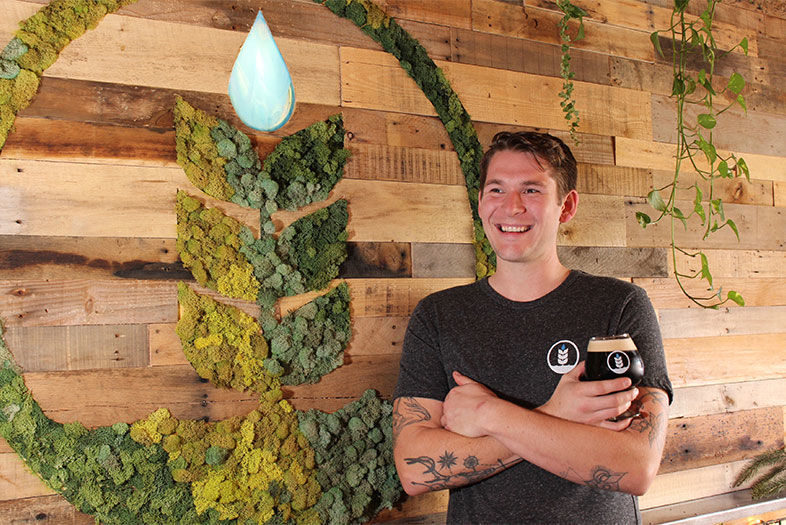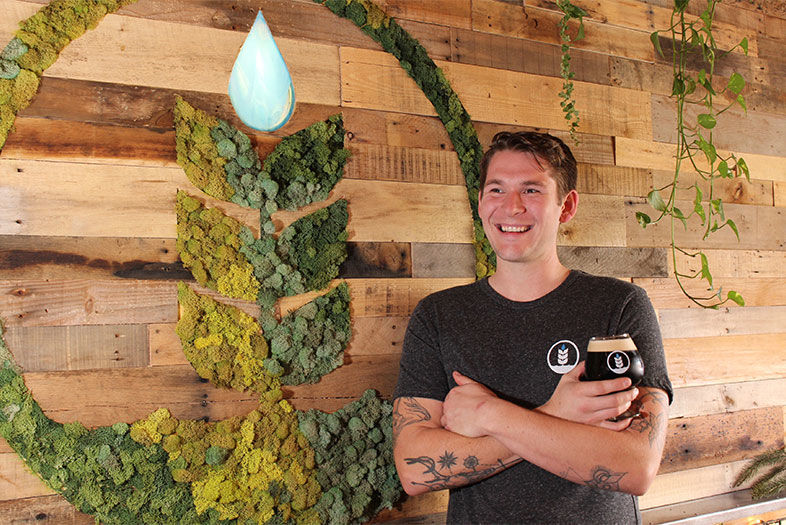Winslow Sawyer is a guy who loves making stuff by hand. Having spent a good deal of time in Northern California—particularly in Berkeley and the Santa Cruz area—Winslow is a true believer in taking the artisanal approach to just about everything—especially food, wine, and beer.
I sat down with a large, cold glass of Evangeline (his awesomely refreshing grapefruit gose) and asked Winslow about his approach to brewing, what has surprised him most during his first year brewing in San Diego, and how he’s adjusted to life here in SoCal.
The first thing I want to talk to you about is how you came down from Northern California—from a very different brewing scene. Most of our brewers are San Diego natives, or have been brewing in this community for a long time. So, let’s start with where you were before coming to San Diego. The company was…?
Boulder Creek Brewing Company, which was up in the Santa Cruz Mountains. They were the thirteenth brewing company in California. They were brewing for twenty-five years but, unfortunately, the brewery burned down in March of 2015. That’s how and why I came down here.
Do you consider yourself a Northern California native?
Well, I was born in Berkeley, but we moved around a lot. My dad was a minister, so I went to high school in L.A. and then went to college in Santa Cruz. I wound up staying in Santa Cruz for eight years.
Was Boulder Creek your first brewing job?
I worked at Seven Bridges in Santa Cruz, which is a homebrew store—actually the only organic-certified homebrew store in the world, and it’s a co-op. I worked there with a lot of really great people, including the original head brewer from Figueroa Mountain.
So Boulder Creek was your first actual brewing gig.
Yup. Right when I turned twenty-one. I knew I was interested in making beer—when I was eighteen I was already homebrewing. I grew up with family friends that started Lucky Baldwin’s Pub and they were really good friends with Mark (Jilg) at Craftsman. So I grew up drinking Craftsman, but then I got to college and everyone was drinking Coors Light and I couldn’t get people to drink good beer! So I decided I could just make it myself, especially the English styles, which are fairly low alcohol, they have a nice ester profile, and are not difficult to brew. That way I was able to make the quality of beer that I liked. Honestly, I like making things. It’s the whole “Santa Cruz farmhouse” kind of thing. You know, we make soup, and sauerkraut, and pickles, and all that stuff. I really love the process of making things and being able to share something you make with someone else. Being able to see the sense of appreciation and joy that you give another person, that’s really great for me. I’ve had a lot of different jobs, I’ve been in the corporate sector—I’ve built dive computers for the Navy SEALS, for example—but it just wasn’t the right thing for me. I really wanted to work with my hands. Five years ago, with craft beer getting even bigger, I knew that was what I wanted to do. I was given an amazing opportunity—I won this home-brew-to-pro-brew competition and then made my beer at a local brewery, Seabright Brewery, which is how I got the job at Seven Bridges. Then, from there, I started working at Boulder Creek as an assistant brewer and— within the year—became head brewer, so I was running things at the age of 22. That’s another opportunity most people don’t get.
How big an operation was it at that point?
It was a seven-barrel system. We were on track to do about 1,200 barrels for the year.
Boulder Creek sounds very unique. What was the coolest thing about working there?
It was a town of 2,000 people. That small-town vibe was really great. I’d walk down main street—past the one stop sign!—and I would wave to everybody and say hi. Plus I was really close to a great state park—I love hiking and the outdoors. I had a creek where I could fish for trout right outside my house. It was a nice experience.
What do you see as the biggest differences between the Northern California beer community and down here in San Diego?
There’s a lot more farmhouse influence in Northern California. Down here you have the most gorgeous, well-built breweries in the world, but up in Northern California it’s a lot more like pieced-together dairy tanks, and pseudo-sterilization-sanitation practices. The Boulder Creek system was thirty-five years old, and it had passed through a lot of different brewers. All our tanks were different sizes, so every time you brewed a beer into a different tank, you had to change the recipe! We had old English grundy tanks in the walk-in and a real underground cellar with our barrels down there for aging. We brewed on a septic system, which is crazy. It was definitely different from here. Kind of back-woodsy.
And down here you feel it’s more technologically oriented?
It’s more legit. And more manufacturing oriented. It’s about having your core brand and building that out, and just really nailing those beers and making them consistently. And it’s different with San Diego being such a strong appellation. You can definitely tell a San Diego beer when you have it.
How did you feel you had to adapt when you came down here to brew?
The beer down here is definitely more hop forward, a little more bitter—sometimes even with acrid flavors. People really enjoy those down here. Also the weather plays a big part. When I first moved down here I noticed that no one even has stouts on tap anywhere. And now that I’ve lived here for a year and half, I don’t drink stouts anymore! And I get it. It’s sunshine every day, it’s tropical weather. You want to drink pale ales and lighter beers. That’s how it works.
“There’s a lot more farmhouse influence in Northern California. Down here you have the most gorgeous, well-built breweries in the world, but up in Northern California it’s a lot more like pieced-together dairy tanks, and pseudo-sterilization-sanitation practices.”
I did notice, when you first opened, your initial lineup included some more offbeat styles. You had a gose, an orange cream ale, and a flavored saison. That’s kind of unusual for a really small brewery just out of the gate.
I like making people happy and I try to make something for everyone. A lot of people don’t like hops or dark beer or sweet beer. We’re also trying to do the more “boutique” thing, where certain beers fulfill a certain flavor profile that we want to offer all the time, but the styles within those categories will change. So the Evangeline (gose) would be the same as having our Beliner Weiss, it just switches out for that. So we like having a different beer all the time, but each one fills out a certain flavor genre that we want to keep. We want to stay away from the “flagship brand” thing and concentrate more on what’s fresh, local, and seasonal right now.
How are the beer drinkers different in San Diego?
It was kind of daunting when we opened, because people would come in and taste a beer and say, “Oh, this doesn’t taste like Sculpin, this isn’t a good IPA.” So we had to start taking the approach of educating people and saying, “Yeah, there’s 130 really good breweries down here and if you want Sculpin there’s plenty of places to get it.” So a lot of beer drinkers didn’t like our beers at first because they weren’t “in tune” with San Diego beer as they saw it. A lot of people came in and were telling me what they thought the beer should taste like—everyone is really knowledgeable about beer down here.
Were there beers that really surprised you for the reception that they got?
Yeah, our cream ale that I put vanilla and local naval oranges in. That was our bestseller when we opened. I was really surprised because I had made a shitload of IPA—you know, I was thinking, “Ok, this is an IPA town and people are going to drink a bunch of IPA,” but it ended up that everyone was really drinking the cream ale.
What’s been your favorite ingredient to work with so far?
Actually, it’s the dragonfruit that we use in the Delphine Berliner Weiss. It just has this crazy electric purple-pink color that looks fake when we put it in the beer. I don’t want to put too much of it in because it will make it look like we’re using fake ingredients. You look at it and think, “There’s no way this color exists in nature!”
You guys haven’t even been open a year, but it feels like you’ve done an awful lot. Does it feel like more than a year to you?
Oh, man. Yeah, we’ve come a long way.
You’ve hit a couple of really impressive milestones already, certainly considering your age. You won a medal at GABF this year.
That was so exciting. At Boulder Creek we sold all of our beer in house, it was all on draft. So there was no reason to ever enter competitions, or even sell kegs to other places. No one got the beer except us. That’s why it’s no wonder that no one has ever heard of Boulder Creek Brewery. So this year was my first time entering real competitions and the first time I got to go to GABF. And we won a medal for our Rose’s Red in the Belgian-style Sour or Lambic category. It was very exciting. I actually accomplished a lot of what I wanted to do with my entire life in this one year!

Have a Beer with Pure Project Brewer Winslow Sawyer
PARTNER CONTENT
Pure Project brewer Winslow Sawyer | Photo: Bruce Glassman

















